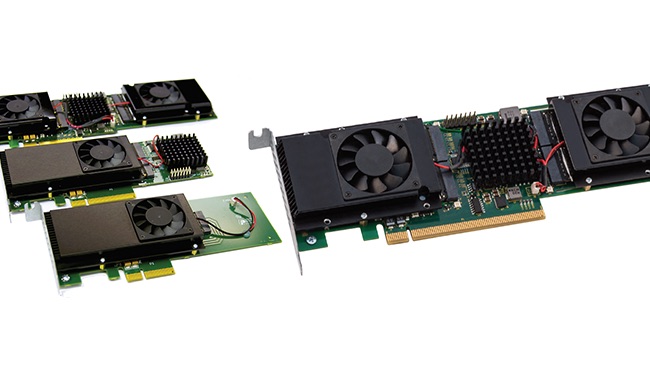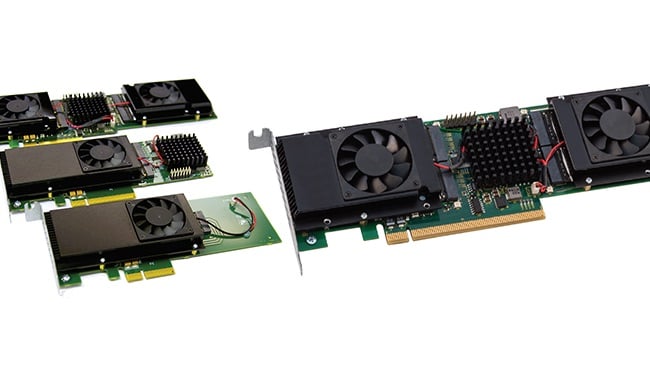

JMR, based in Chatsworth, California has announced three new SiloStor PCI Express SSD cards billed as ideal for computer-intensive workflows, ie anything to do with video.
The company's press release tells us about the uses for fast SSD storage, which is pretty much what you would expect: “The newly developed JMR SiloStor NVMe SSD drives are ideal for compute intensive workflows including HPC, data centres, genome research, content creation, CGI/Animation, codec processing and gaming, to name a few.”
And then we get down to brass tacks about the hardware. The SiloStor family comes in three configurations:
- Single drive module NVMe/PCIe: x4 PCIe connectivity, available in 512GB/1TB/2TB capacities. Half-height, half-length card
- Dual drive module NVMe/PCIe: x8 connectivity, available in 1TB/2TB/4TB capacities. Half-height, half-length card
- Quad drive module NVMe/PCIe: x8 connectivity, available in 2TB/4TB/8TB capacities. Half-height, full-length card.
The Dual drive and Quad drive cards incorporate a PCIe switch and the drives can be striped (on a single card) for additional performance. All SiloStor designs incorporate active heat sink coolers on the drive modules themselves, maintaining low operating temperature even during intensive sequential write operations.
The single drive unit utilises x4 PCIe (Gen 2 or Gen 3); the dual drive and quad drive units utilise x8 PCIe (Gen 2 or Gen 3) and can fit expansion slots having more lanes than required, e.g., the x4 single-drive SiloStor works in x4, x8 or x16 slots, etc.
Specifications:
Available Native Storage Capacity: 1-drive: 256, 512, 1,024, 2,048GB; 2-drive: 512, 1,024, 2,048, 4,096GB; 4-drive: 1,024, 2,048, 4,096, 8,192GB
Average access time: <1 mS
Monitoring: S.M.A.R.T.
MTBF: 2 million hours
Endurance: 1,200 TBW minimum
Power consumption: 40W (bus powered) worst case (4-drive SiloStor)
Performance for 4-drive SiloStor
Random 4K read speed: > 90,000 IOPS
Random 4K write speed: > 70,000 IOPS
Sequential read speed: > 4,000 MB/s
Sequential write speed: > 3,000 MB/s
IOPS: 330,000 (Based on 4K, with a queue depth of 32)
Operating temperature: 0-70°C (integrated active cooler)
NAND type: 1, 2 or 4 * 512GB to 2,048GB V-NAND M.2; integrated switch in 2-drive and 4-drive models
Form factor: Half-height, half-length PCIe (1 and 2-drive models); half-height, full-length PCIe (4-drive model)
PCIe connection: x4 (single drive); x8 PCIe (dual and quad drive models)
Weight: 10 oz (285 gm) maximum (4-drive model)
Warranty: 3 years or 1,200TBW
And that’s the end of the Press release.
So we have learned that SiloStor is based on M.2 NVME SSD storage technology and you can buy the cards in versions with one, two or four M.2 SSDs. However, that didn’t tell us all we wanted to know. We asked JMR for further details and were told: “Our SiloStor products work with a variety of M.2 drives, but we are shipping with the Samsung 960 PRO enterprise-class drives (including the 960 EVO as well). The PCIe switch used in the 2-drive and 4-drive models comes from PLX.”
That sounds very promising as Samsung and PLX are both respected companies. Balanced against that we are talking about serious expense as a 2TB Samsung 960 PRO SSD in the UK currently costs £1,050 so the hardware for the maximum 4x2TB card will cost around £5,000.
However, JMR emphasises that SiloStor has been designed to accommodate enterprise class M.2 drives, which means it is considerably more than a simple PCI Express-to-M.2 adapter. One minor feature worth pointing out is the inclusion of an activity status LED indicator. A more significant point is that SiloStor products all have active coolers on the M.2 drives so they can be used happily without concerns about thermal throttling.
Tags: Production



Comments